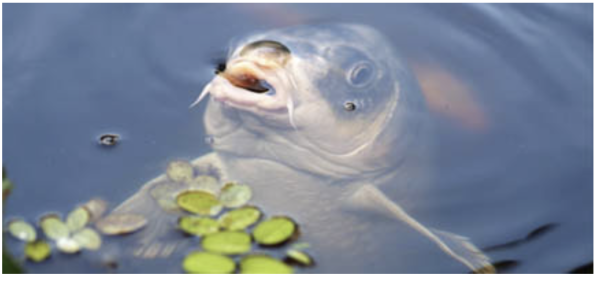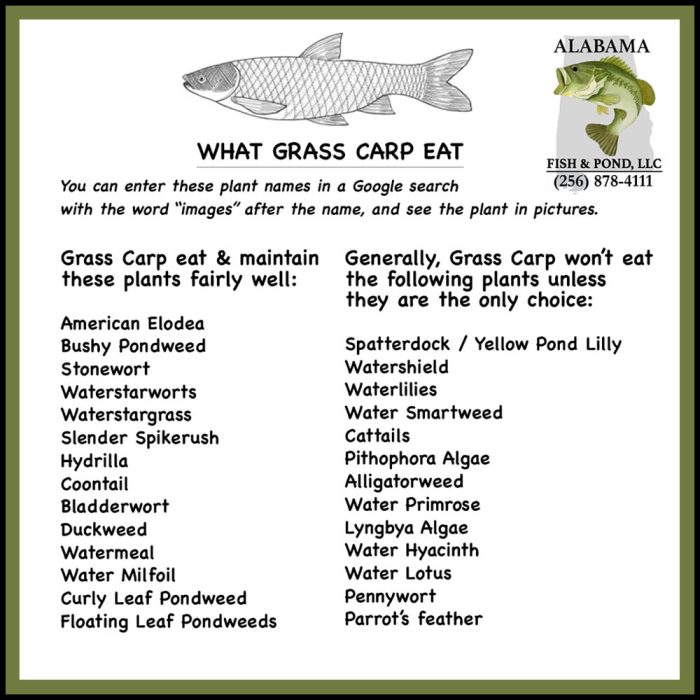
USING CARP and TILAPIA TO FIGHT WEEDS And ALGAE
WHITE AMUR GRASS CARP
Grass Carp are an excellent option for clearing your pond of certain species of invasive aquatic weeds. Carp do have favorite weeds, so it is important to know if your pond/lake weeds are among those that they like to eat. There is a List at the bottom of the page telling you what they like and don’t prefer.
If you need help identifying the weeds in your pond, contact your local County Extension Office and ask for the Agent that deals with ponds. Ask if you can bring in a baggie with the type of weed in your pond. They you can determine if Carp will help you with your pond’s weeds, or if you must use an Herbicide or manual removal. For example, Lily Pads must be pulled or treated to remove them.
It might surprise you that carp can live up to 20 years, and can be expected to clear 75 to 100% of pond vegetation in the first year if they are stocked at the right size and in the right quantity.
We recommend that you stock Carp at 5 to 25 to the acre, depending on the percentage of coverage of weeds in your pond… so half covered would be 10 to 12 Carp if your budget allows that many. You can keep adding them until you have enough.
Carp prefer the softer aquatic weeds, leaving the floating plants like Lilies, Pickerelweed, Watermeal and Duck Potato alone. It is beneficial that Carp do not eat this floating vegetation, because it provides fish habitat and additional nutrients in your pond. If you overstock Carp they can clear out the vegetative habitat, to the destruction of fingerlings trying to hide from Bass and other predators.
It is a good idea to plant Pickerelweed and Duck Potato in shallow water before introducing Carp to clear other weeds. Your pond also needs natural hiding structure (like tree branches) in shallow areas, to a depth of 5′ to protect fingerlings as they grow.
Carp can get fat and lazy like Catfish will if you feed pellets. Some may stop eating weeds and wait in front of the Feeder for their daily meal. This usually takes them a few years to figure out, but if you see some hanging around the Feeder as time passes, they should be shot or fished out.
The size Carp you stock is important. If you have adult Bass in your pond, any size less than 12″ is likely offering the Bass a meal. It is best to stock Carp at 12″-14″ when you have adult Bass. Anything a Bass can get it’s mouth around becomes a meal. A 14″ Carp is about 2 lbs, and will be able to avoid becoming lunch much better than a 10″ Carp.
It is common to experience a 20-30% loss in your Carp the first few years. If you stock them in the Fall, increase the quantity to cover this normal loss. Stocking Carp in the Spring before the plants get fully underway will give them a better chance and should reduce this loss percentage.
If you have a fairly heavy weed load in your pond, stock at 10-15 Carp per surface acre. If the weed load is not so heavy, 10 Carp per acre is a good number, but you must also see that your pond has the shallow water vegetation and structure (tree limbs) to the 5′ depth. If you stock Carp at the correct number and time of year for their best success (early Spring), you should find that you do not need to restock them each year for several years.
If you stock Carp and still have to many weeds come mid-Summer then you need to add more Carp. If you fertilize your pond it will accelerate weed growth, and you will need to add Carp to the level required to control the weed growth. Estimate the number of surface acres of weeds and then stock the recommended number of Carp for that total in surface acres.
After the Carp clear your pond of undesirable weeds you may need to reduce their population to a level that maintains the pond free from weeds, but doesn’t start to clear out your beneficial vegetative life (until you fertilize again). Fishing them out or shooting them are the main options to reduce their population.
If your pond has an outflow of moving water, beware that Carp are drawn to water-flow and may seek to escape. You need to rework that aspect of your pond system if possible, to prevent them exiting your pond.
TILAPIA – Sterile or Reproducing
Tilapia will eat their weight in soft weeds and algae daily. They can significantly assist in removal of algae in a pond. Tilapia will go from 1″ to 2″ in early Summer to 10″ to 12″ by Winter. That’s is a lot of growing and eating!
The combination of Carp and Tilapia can really help pull a pond or lake back in order if soft weeds and algae have gotten the upper hand.
The downside is that Tilapia will die when pond water temperature drops below 60 degrees in winter. If your pond has an incoming water source that is warmer, Tilapia will congregate there and may survive the winter. Otherwise you must fish or net out the Tilapia before they belly up come Winter, if that matters to you.
Reproducing Tilapia are a good source of food for Bass. Tilapia are great to eat as well – so you can stock your freezer and clean up your pond.
